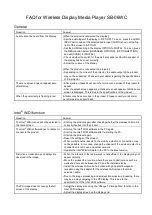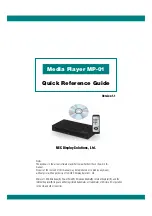
9
12. PITCH BENDING
The speed increases or decreases respectively while the PITCH BEND+ or PITCH BEND- button is
pressed. The extent, to which the speed changes, is proportionate to the amount of time the button is
pressed. For example, if the PITCH BEND+ button is pressed continuously, the speed increases
continuously. The pitch changes within a range of +/-8%, +/-12% or +/-16%.
Activating the Pitch Fader
To activate the PITCH fader (
19
), turn the pitch function on. Press the PITCH button (
21
) to turn on the pitch
function, when the pitch function is activated the PITCH LED (
22
) will light up. If the pitch function is not
activated neither the PITCH fader (
19
) nor the PITCH BEND buttons (
18
) will function.
Using the Pitch Slider
To use the PITCH fader (
19
) slide the fader up or down. Down will increase the pitch and up will decrease
the pitch. The PITCH PERCENTAGE INDICATOR (
40
) in the LCD (
3
) will detail the amount of pitch being
applied to the track. When the slider is in the center position, zero pitch is being applied to the track and the
PITCH PERCENTAGE INDICATOR (
40
) will read zero.
If the PITCH fader (
19
) is set to a 2% pitch gain the pitch bending process will begin at 2% and will continue
to the maximum of -/+16% and then return to the original 2% pitch when the button is released.
If the (+) PITCH BEND BUTTON (
18
) is held down continuously, the disc speed will increases and will
continue to increase until reaches a maximum of 16% speed gain.
13. CREATING AND PLAYING A LOOP
A loop is a sound clip that plays continuously between two points. You can use this loop to create a
dramatic effect into your mixing. This loop has no time limit and you could actually loop the entire disc
length. You create a loop between two continuous points of a disc. The following steps illustrate the
procedures for creating a loop:
1) Press the PLAY/PAUSE button (
8
) to activate playback mode.
2) Press the IN button (
6
). This will set a loops starting point. The IN button (
6
) LED will briefly indicating a
starting point has been set.
3) Press the OUT button (
11
) to set the ending point for your LOOP. The IN button LED (
9
) and
OUT button LED (
16
) will start flashing, indicating the LOOP mode has been activated.
LOOP INDICATORS
During a loop, the IN button LED (
9
) and OUT button LED (
16
) will begin to flash indicating the LOOP mode
has been activated. A loop will remain in memory until a new loop is made or the unit has been powered
down or disc is removed. When a loop remains in the memory, but has been deactivated, the IN button LED
(
9
) and OUT button LED (
16
) will light red.
EXITING A LOOP
To exit a LOOP when a loop is active, press the OUT button (
11
). The IN button (
10
) and OUT button (
11
)
LEDs will remain on, but they stop flashing. Music playback will resume its normal play. The IN button (10)
and OUT button (11) LEDs will remain on, to remind you that a loop is stored in memory.
REACTIVATING LOOP
To reactivate a LOOP that is stored in memory but is not playing, press the OUT button (
11
). The IN button
LED (
9
) and OUT button LED (
16
) will begin flashing, indicating the LOOP has been activated.
14. SWITCHING BETWEEN SINGLE AND CONTINUOUS PLAY MODES
This unit allows you to switch your play mode between single and continuous.
Continuous mode allows the seamless CD playback without interruption.
Single mode will play a track and cue to the next track when the previous track has ended. In certain
situations this may be useful to prevent unintentional playback of an unwanted track. To switch between the
playback modes press the SGL/CTN Button (
4
).
Mode Indicator
: The "SINGLE" INDICATOR (
39
) will show in the LCD screen (
3
) when the unit is in
Playback Mode. When the unit is in Continuous Playback Mode the "SINGLE" INDICATOR (39) will turn off.
Summary of Contents for TL-500
Page 1: ...TL 500 ORDERCODE D1130...
Page 15: ...2006 DapAudio...

































